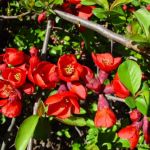| Common Name: |
Flowering Quince |
| Other Names: |
Japonica, Japanese quince |
| Botanical Name: |
Chaenomeles speciosa |
| Genus: |
Chaenomeles |
| Family: |
Rosaceae |
| Native Location: |
Woodland China |
| Cultivation: |
Well-drained soil in sun or partial shade, either in the open or trained against a wall. Fruiting is best in sun. Plants grown in the open need little pruning other than thinning out or shaping branches after flowering. Prune wall-trained specimens after flowering, reducing the previous year's growth to two or three buds and cutting back any outward-growing shoots. Plants may be affected by fireblight and may suffer from chlorosis on very alkaline soils. |
| Propagation: |
By seed sown in autumn and placed in a cold frame; by semi-ripe cuttings in summer; by layering long shoots in early autumn. Cultivars do not come true from seed. |
| Harvest: |
Fruits are gathered when ripe in the autumn and dried for use in decoctions, or consumed fresh. |
| Variations: |
Cameo
Is a compact shrub with few thorns, producing semi-double, apricot-pink flowers and greenish-yellow fruits with a lemon-like aroma.
Height: 1-1.5m (3-5ft)
Moerloosei syn. 'Apple Blossom'
Has dense clusters of pink-flushed, white flowers that resemble apple blossoms.
Nivalis
Has pure white flowers
Simonii
Has large, double, deep red flowers. |
| Height: |
2.5m (8ft) |
| Width: |
5m (15ft) |
| Hardiness: |
Z4-8 |
| Parts Used: |
Fruits (mu gua) |
| Properties: |
An anti-inflammatory and anti-spasmodic herb that acts mainly as a circulatory and digestive stimulant. |
| Medicinal Uses: |
Internally for rheumatism, arthritis, cramps (especially in the calf muscles), painful, weak, or swollen lower limbs, stomach cramps due to indigestion, diarrhea, and vomiting. |
| Culinary Uses: |
Fruits may be used as a substitute for quince (Cydonia oblonga) in jams and jellies, and for flavoring apples and other stewed or baked fruits. |
| Bibliography: |
Encyclopedia of Herbs by Deni BrownCopyright © 1995, 2001 Dorling Kindersley Limited. pp. 163-164 |
